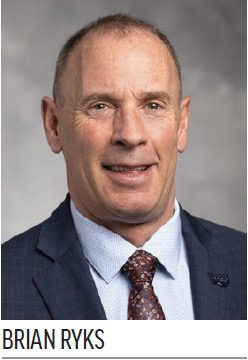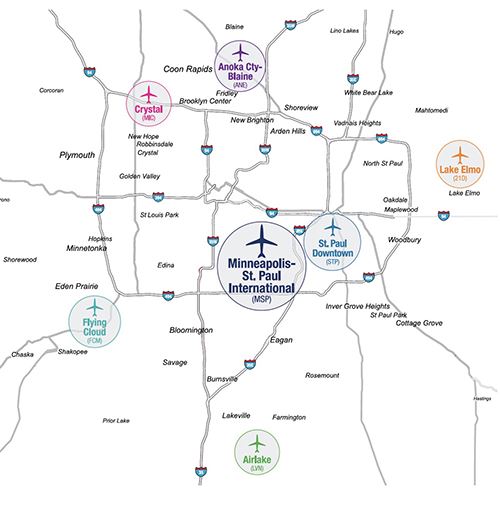The six general aviation airports operated by the Metropolitan Airports Commission (MAC) are called relievers for a good reason: They significantly reduce traffic pressure that would otherwise congest Minneapolis-St. Paul International (MSP), the major airport of the system.
The six general aviation airports operated by the Metropolitan Airports Commission (MAC) are called relievers for a good reason: They significantly reduce traffic pressure that would otherwise congest Minneapolis-St. Paul International (MSP), the major airport of the system.
They surround the Twin Cities metro area, and provide valuable outlets for flight training, military operations, corporate and recreational flying, and emergency medical flights.
While MSP experienced a 40% decline in operations during 2020 due to the impacts of the COVID pandemic, total operations at the six relievers actually grew by 2% (to 326,000). Officials estimate that together, they contribute $756 million in total economic output, and support more than 1,000 direct jobs.
|
facts&figures
Project: Metropolitan Airports Commission Location: Minneapolis-St. Paul metro area Airports: 6 Relievers For: Minneapolis-St. Paul Int’l Total 2020 Operations: 326,044 Runways: 14 (13 paved; 1 turf) Leases: 828 (764 aircraft storage, 35 commercial properties, 28 non-aeronautical uses) Based Aircraft: 137 Annual Fuel Sales: More than 6.2 million gallons Combined Property: 5,007 acres Engineering Consultant: SEH Contractors for Lake Elmo Runway & Taxiway: Designing Earth Contracting; Minger Construction Key Benefits of Reliever System: Reduces congestion at Minneapolis-St. Paul Int’l; bolsters economy of metro region |
Flight training and leisure flying was up at most of the relievers. “It’s amazing to see the growth in grassroots aviation, even in the face of a global pandemic. The fact that people can operate aircraft safely while implementing COVID protocols is certainly positive,” says Joe Harris, director of reliever airports for MAC. “We have seen a tremendous demand in flight instruction in both new pilots and licensed pilots seeking advance training and certifications. I have met flight students who attend aviation programs around the United States who came back to the Twin Cities metro area to continue their training while distance learning.”
Flying Cloud Airport (FCM), located in Eden Prairie, and Airlake Airport (LVN), located in Lakeville, recorded the largest increases within the MAC system. At FCM, flight operations increased by 19%—nearly 10,000 operations over 2019. In fact, it was the 13th busiest airport in the country (commercial and general aviation) on May 12, 2020, with COVID-19 raging.
LVN was up 5% from 2019, with close to 1,500 more operations in 2020.
Not everything was rosy, though. Operations at St. Paul Downtown Airport (STP), which usually hosts significant corporate jet activity, were down 26% in 2020, mostly due to the pandemic. However, business aircraft operations rose significantly this past summer, and that growth is expected to continue despite the impacts the pandemic continues to have on commercial business travel.
The other three reliever airports experienced minor decreases. Traffic at Lake Elmo (21D) was down 4.5%; Anoka County-Blaine (ANE) held almost steady with a 1.2% decline; and Crystal (MIC) dipped 4.9%.
Brian Ryks, chief executive officer of MAC, oversees the entire reliever network and MSP. “These reliever airports are a vital part of our community,” says Ryks. “They provide wealth to the region’s economy, so it’s important that we provide these airports with the proper infrastructure needed to allow them to grow and prosper.”
 The reliever system was established so MSP could function efficiently as the primary hub for commercial passenger and air cargo operations. Due to the size of MAC’s network, general aviation pilots have a wide choice of which reliever airport to use.
The reliever system was established so MSP could function efficiently as the primary hub for commercial passenger and air cargo operations. Due to the size of MAC’s network, general aviation pilots have a wide choice of which reliever airport to use.
The relievers were especially valuable during two huge recent events in Minneapolis. “In 2018, when we hosted the Super Bowl, we had 1,100 private aircraft come here,” Ryks recalls. “We only could handle about 150 of these planes at MSP; the rest of them flew into our reliever airports.”
A similar situation occurred a year later, when Minneapolis hosted the NCAA Final Four men’s basketball tournament in April 2019. Most of the 650 private jets that flew to the region landed at one of the relievers.
While most of Ryks’ daily responsibilities involve major projects at MSP, he has championed strategic infrastructure investments throughout the reliever system.

“We did a major runway project at Crystal in 2020, and at Lake Elmo we are in the process of completely relocating the main runway and reconstructing the existing runway as a taxiway,” Ryks remarks. “We are working with the FAA on a possible relocation of a new air traffic control tower at Flying Cloud. And at Airlake, we are planning a new development area so we can add more hangars.”
The pipeline to bring such projects to fruition begins with the three managers who oversee day-to-day operations at the six relievers. Each supervises two airports. Besides managing routine maintenance, working with tenants and providing regular financial updates, they also are tasked with providing input about forecasting demand and the timing for major construction projects.
Individual managers work closely with Harris to develop an annual budget for each airport. Major project requests are reviewed by the commission’s vice president of planning and development, and presented to the executive staff. Then funds are allocated to each facility. Large-budget projects often depend on FAA and state funding to get the green light.
Community Engagement
Since becoming chief executive officer of MAC five years ago, Ryks has expanded community outreach efforts involving MSP and the reliever airports. “There are 24 cities or townships that are close to one of our relievers, and I often meet with the mayor and/or city council members when one of our projects affects their jurisdiction,” he says.
For example, Ryks and other MAC officials participated in 20 public meetings about the Lake Elmo project alone. “I met with various state senators and representatives who expressed concerns about reconfiguring a local road next to the airport, as well as possible noise increases,” Ryks explains. “The meetings allow us to explain our projects, and then to address concerns brought up during those discussions.”
One of MAC’s biggest community outreach efforts, AirExpo, was held at Flying Cloud in late July. The annual two-day event (canceled in 2020 due to the pandemic) featured an air show and aircraft display. One particularly popular event allowed children to paint an airport plow. This year’s attendance of approximately 7,000 people exceeded expectations.
Another example of community engagement is an online e-newsletter that runs on the MAC website. This August, it addressed the increase in planes flying over certain neighborhoods by student pilots from flight schools.
Money Matters
The budgeting process for MSP and the six reliever airports is a delicate balancing act. “We look at it as asset management,” states Bridget Rief, MAC’s vice president of planning and development. “We identify the priorities among these airports, and develop a capital improvement plan for MSP as well as the six general aviation airports.”
 Rief’s division oversees property acquisition, planning, design, engineering, architecture and construction of all airport facilities. It also ensures that environmental standards and regulations are met and enforced. As a matter of course, proposals for capital improvement projects go through Rief. Larger projects, such as the multi-year $19 million Lake Elmo runway project, receive input from all senior staff at MAC.
Rief’s division oversees property acquisition, planning, design, engineering, architecture and construction of all airport facilities. It also ensures that environmental standards and regulations are met and enforced. As a matter of course, proposals for capital improvement projects go through Rief. Larger projects, such as the multi-year $19 million Lake Elmo runway project, receive input from all senior staff at MAC.
The development staff currently has 13 people, including seven project managers. With no in-house consultants on staff, Rief uses about one dozen outside consultants, on a rotating basis. Most are involved in large projects at MSP.
One consultant, SEH of St. Paul, is dedicated just to the relievers. “They have been instrumental during the current Lake Elmo runway project,” says Rief.
On average, the annual operating budget for all six reliever airports ranges from $5 to $7 million. The most common annual line expenses are related to the operations and management of airfield infrastructure and capital equipment assets and facilities. Large-scale construction projects typically depend on FAA and state assistance. The Crystal Airport project in 2020 cost about $7 million. The current Lake Elmo project is budgeted at $19 million over a three-year period. Both were mostly funded by the FAA.
The total annual budget for MAC is somewhat fluid, which Rief considers a good thing. “There are many external factors that we face each year,” she says. “MSP needs expensive upgrades each year, so projects involving relievers are prioritized based on their own budget constraints and other CIP demands.”
One project officials hope to tackle soon is building a new control tower at Flying Cloud, the busiest of the six relievers. “We are coordinating with the FAA on where it should go if approved, and how it should be built to meet their regulations,” Rief remarks. “The preliminary estimated cost of this is about $10 million.”
Budgets for the reliever airports are developed at least three years out. “In 2022, we have the funding in place to finish the Lake Elmo project; this will take the lion’s share of our 2022 budget for relievers,” she affirms.
A project in the pipeline for 2023 is a runway extension and reconstruction at Airlake. Its estimated cost is $7 million.
Budget decisions for 2024 are currently in the works. “The St. Paul airport needs runway work as well as LED lighting,” Rief details. “We will ask the FAA for federal funding for that. In addition, all six airports have pavement maintenance needs, so those projects are also candidates for grant money in the near future.”
Daily Coordination
As the director of MAC’s six general aviation airports, Harris leads a staff that includes 28 employees who help him manage the complex reliever system. His staff oversees the administration of more than 800 leases, including 35 commercial operators. About 1,300 aircraft are based at the six airports. Four of the relievers have air traffic control towers.
 Managing all these pieces requires detailed organization. “Having a great team makes a huge difference,” Harris says. “They deserve all the credit. They are master practitioners who are incredibly thorough and always willing to lend a helping hand to play a crucial role in MAC’s success. I make a point to visit each location to interact with our staff as well as our partners.”
Managing all these pieces requires detailed organization. “Having a great team makes a huge difference,” Harris says. “They deserve all the credit. They are master practitioners who are incredibly thorough and always willing to lend a helping hand to play a crucial role in MAC’s success. I make a point to visit each location to interact with our staff as well as our partners.”
Harris receives daily reports on all active construction projects. This year, the runway relocation at Lake Elmo required teamwork from on-site airport personnel, Harris’ team and other MAC officials. He gets daily reports from Phil Tiedeman, the Lake Elmo manager, who also manages Anoka County-Blaine Airport. Brad Latvala, the senior airport maintenance worker under Harris, provides frequent updates on construction progress and related issues as well.
Each step of the Lake Elmo construction is also monitored by Lindsay Reidt, SEH’s lead consulting engineer for all six reliever airports. Jake Jorgenson from SEH is the on-site engineer. Harris usually tours the construction site with these consultants at least once a week.
Senior MAC officials, including Rief and Chad Leqve, vice president of management and operations, are continually updated about the progress of big projects such as Lake Elmo.
The reliever airports are expected to be as self-sustaining as possible. “At a minimum, we want revenue from these six relievers to offset their operational and maintenance costs,” Harris explains. “Landing fees apply to Jet-A aircraft operators at St. Paul Downtown, Anoka County-Blaine and Flying Cloud. Additional revenue throughout the reliever system comes from hangar rentals and fuel sales.”
A relatively new source of revenue is Holman’s Table, a restaurant that opened at St. Paul Downtown Airport in 2018. Harris notes that its views of the airport’s main runway and the Mississippi River make it a major attraction for both airport users and people from the Twin Cities metro area. In all, the reliever airports collect average annual revenue of about $10 million, which meets the target goal of equalizing their annual operational and maintenance expenses.
Continued Growth
Harris is optimistic that traffic at the six reliever airports will continue to grow in 2021. “In the second quarter alone this year, our operations jumped 19% from 2020,” he reports. “In addition, fuel flowage, landing fees and rent from new hangar construction are all trending higher.”
Private investment in new businesses is also escalating. Flight schools are shattering previous enrollment records, and some have even ordered more aircraft to meet demand. Currently, private companies are investing about $30 million in projects at the reliever airports.
Harris expects business traffic to increase as the economy strengthens in the second half of 2021. “We have jet activity at five out of our six reliever airports,” he says. “The number of operations in that category is surging past pre-pandemic levels.
|
MAC Relievers in a Nutshell Airlake Airport (LVN) Located south of the Twin Cities, near Lakeville and Farmington, LVN has a single 4,098-foot runway that logged 31,314 operations last year. Although it is used primarily by recreational pilots, LVN is located near one of Minnesota’s largest industrial parks. A fixed-base operator provides fueling and other aircraft maintenance service. The airport does not have a tower. Employees: 31 2020 Operations: 31,314 — up 5% vs. 2019 Total Economic Output: $13.2 million/year Anoka County-Blaine Airport (ANE) This airport serves a very diverse mix of aircraft with two runways (one 5,000 feet long). MAC owns the tower, but contracts with the FAA for Air Traffic Control. A footprint of 3,000 acres makes ANE the largest reliever in the MAC system. Its collection of 400 based aircraft runs the gamut, from vintage 1920s planes to the most modern jets. The control tower, which opened in 1996, is used as a practice facility for air traffic controllers. Employees: 130 2020 Operations: 70,852 — down 1.2% vs. 2019 Total Economic Output: $118 million/year Crystal Airport (MIC) Crystal Airport borders Brooklyn Park and Brooklyn Center in the northwestern part of the Twin Cities metro area. Currently, MIC has two paved runways, one turf runway and three non-precision instrument approaches. It is the closest of all MAC relievers to Minneapolis’ business district. Employees: 100 2020 Operations: 39,509 — down 4.9% vs. 2019 Total Economic Output: $71 million/year Flying Cloud (FCM) FCM is located in Eden Prairie, in the southwestern corner of the Twin Cities metro area. It features two runways, which are used by corporate jets, turboprops and helicopters. As one of the busiest airports in the reliever system, Flying Cloud has an FAA-operated control tower and an instrument landing system. Many large companies have hangars at FCM. Employees: 340 2020 Operations: 124,382 — up 19.1% vs. 2019 Total Economic Output: $229 million/year
Lake Elmo Airport (21D) Lake Elmo is located in the northwestern corner of the Twin Cities metro area and is served by a fixed base operator and an aircraft maintenance provider. Currently, the airport is in the midst of construction to relocate its main runway and convert the existing runway into a taxiway. It is a non-towered airfield. Employees: 14 2020 Operations: 29,799 — down 4.5% Total Economic Output: $12.8 million/year St. Paul Downtown Airport (STP) Nestled along the Mississippi River, STP has three runways, including the longest (6,491 feet) in the MAC reliever system. Two fixed-base operators provide services such as fueling, flight training and maintenance. Many corporations rent hangars here. Because of its long runway, some large business jets based there can fly nonstop to several destinations in Asia. Employees: 410 2020 Operations: 30,188 — down 26.3% vs. 2019 Total Economic Output: $312 million/year Source: Metropolitan Airports Commission |



